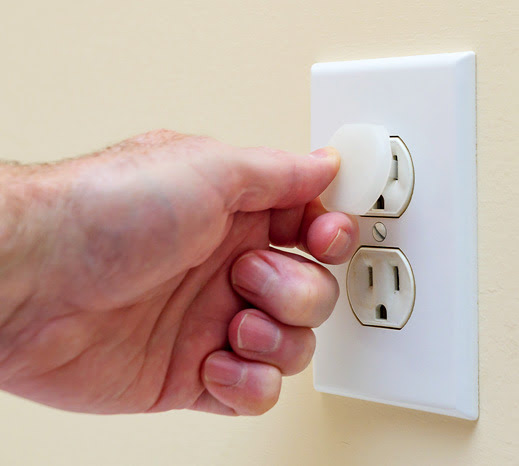Electricity is vital to every modern home, but electrical cords and outlets can pose a hazard to kids and pets who don’t understand them. While you can teach older children about basic electrical safety, you should still take steps to make the electrical fixtures in your home safer—especially when young children and animals are around.
4-Star Electric provides residential electrical services throughout Calgary, so we’re familiar with the most common electrical hazards that the community faces in their homes. Read on for tips on how to reduce the risks associated with electricity and how to better safeguard your family.
Teach Electrical Safety Early
Teaching kids best practices for electricity and electrical outlets early is the best way to keep them safe in the long run. The top ten rules to go over with them are:
- Never put anything into an outlet other than an electrical plug.
- Never put metal objects into toasters.
- Do not use electronic devices around water.
- When unplugging something, pull from the plug and not the cord.
- Do not put anything metal in the microwave. This includes tinfoil!
- Do not touch damaged electrical cords. Tell an adult right away if you see one.
- Do not use electrical appliances if you are wet or standing in water.
- Do not put drinks on top of your game consoles.
- Avoid power lines: do not climb trees or fly kites near them.
- Do not climb on or touch metal transformer boxes.

Avoid Extension Cords
Not only are extension cords a tripping hazard, but they can also act as a bright orange beacon that attracts interested fingers and sharp teeth. The last thing you want is for your child or pet to see it and chew on it, or start playing with it and knock over whatever appliance the extension cord is powering.
Keep an Eye Out for Dangers
As parents, our first job is to keep an eye out for places with exposed hazards that could hurt our little ones. Doing a quick visual sweep of an area before leaving the kids to play can keep them from getting into dangerous situations. Parents can even get down on their kids’ level to crawl around and see if anything dangerous might pull their attention.
Use Outlet Caps
Electrical outlet caps are one of the most tried and true baby-proofing tools. They’re relatively inexpensive and fit snugly over the outlet, effectively keeping kids from sticking their fingers, forks, or other metal objects into the outlet. The exposed area of the cover is also flat, making it difficult for a kid to get a good enough grip on it to remove the cover themselves.
Cover Power Strips
Like wall outlets, powerstrips are another way for kids to unintentionally shock themselves. Parents should avoid using power strips in kids bedrooms and cover the ones that are visible and accessible to keep kids from putting their fingers or other items into them.
Secure Loose Electrical Cords
Loose electrical cords are a tripping hazard and an invitation for mischief when left out in the open. Securing the cords can prevent tripping and make the cords harder to see. When setting up your outlet area remember to:
- Make sure to use the outlet closest to the item’s resting place
- Wrap loose cords up
- Tuck loose cords away
If the cords aren’t visible, little people and animals won’t be tempted to play with them.

Use Nightlights
The easiest way to ensure kids have a safe journey from their room to the bathroom at night is to position nightlights in their bedrooms and dark hallways. We recommend using extra night lights around cords that can’t be tucked away so your child can see them and avoid them if they have to move around at night.
Replace or Repair Damaged Electrical Equipment
Damaged electrical cords provide direct access to live electricity when plugged in. All an unsuspecting person or pet has to do is get too close to it to get a potentially fatal shock. Swapping out a damaged plug for a new one on a lamp is a simple fix. However, replacing the damaged item altogether may be the easiest route if you’re unfamiliar with the process.
Consider Outlet Boxes
An outlet box is a box that screws on over an outlet. Outlet boxes have doors that close and lock over plugs to keep the plugged in item safe and small fingers away from the electrical current. These boxes have room inside for bulkier plugs and an opening at the bottom to allow the cord to connect to the appliance. These boxes work well with larger appliances like TVs, washers, dryers, and other items that need to be plugged in at all times.
Install GFCI Outlets Near Water Sources
Water and electricity do not mix. Install ground fault circuit interrupter outlets, or GFCI outlets, anywhere the outlet is in danger of coming in contact with water. These circuit interrupters will shut down power to an outlet if it detects a leak in the electrical current, i.e. if the current comes into contact with water and tries to move through the person that splashed it to the ground.
Bonus: Electrical Safety Tips for Pets
Just like kids, pets can be curious about different aspects of their home, live wiring and electrical systems included. Fortunately, a lot of the precautions parents take to protect their kids from electricity will also work to protect pets—but here are a few additional steps to take to keep your pets safe from electric shock:
Hide or Cover Exposed Wiring
Out of sight, out of mind! Visible wires can be tempting for pets to chew on and explore. However, if they can’t see them, they won’t be interested in trying to chew on them. Hide or cover exposed cords to keep nosey noses and sharp teeth out of harm’s way.
Invest in Chew Toys
Sometimes pets settle in to get destructive on something dangerous for them to chew on. When you see this, owners should take away the inappropriate item and immediately replace it with something that’s appropriate for them to chew on. Redirections to appropriate chew toys plus leaving toys out and around for them to chew on when they get the urge should help them make a safe choice when they need to relieve stress or expend some pent-up energy.
Block off Areas Where You Can’t Hide The Cords
Sometimes you can’t avoid a cord hanging from an appliance or an outlet. If pets gravitate towards certain areas with cords and seem a little too interested in the cord itself, create a boundary by blocking off of the area. Owners can install gates, set something solid, like an ottoman, in front of the outlet, or just keep doors closed to areas of interest.

Get Help Making Your Home’s Electrical Fixtures Safer
Electricity is part of our everyday lives. It’s important to take steps to ensure that we use it safely, especially with kids and pets around. Taking an extra few minutes to hide cords, cover powerstrips, and swap out outlets can protect your young ones even when you don’t have eyes on them.
At 4-Star Electric, we prioritize safety in every aspect of our work. To learn more about fixing potential electrical hazards in your home, reach out to us and speak to one of our experienced electricians. We can look over your home’s electrical panel and outlets to make sure they’re not in danger of overloading, advise you on the safest places to keep your electrical equipment, and more.


